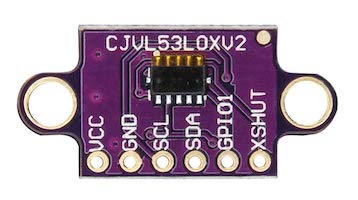ts-vl53l0x
v3.2.0
Published
A Node.js library in Typescript for a vl53l0x device
Downloads
12
Readme
vl53l0x
A Node.js library for a vl53l0x proximity sensor.
NOTE: This package addresses the issue of adding multiple vl53l0x on one device. Please read below how to.
NOTE:
I honestly have very little knowledge of GPIO and hardware programming. This is a fork from https://github.com/williamkapke/vl53l0x
I did this to try and understand a bit more how to develop nodejs -> sensors apis. and to typescript the hell out of it!
Install
From: https://www.npmjs.com/package/i2c-bus#installation The way in which I2C is configured varies from board to board. Sometimes no configuration is required, but sometimes it is:
- Configuring I2C on the Raspberry Pi
- Configuring Software I2C on the Raspberry Pi
- Consider software I2C when there are issues communicating with a device on a Raspberry Pi
npm install ts-vl53l0x
Use
Normal single sensor
import VL53L0X from 'ts-vl53l0x'
const vl53l0x = new VL53L0X()
const init = async () => {
await vl53l0x.init()
while (true) {
console.log(await vl53l0x.api.measure())
// output: { '0': 8191 }
}
}
init()Multiple sensors
import VL53L0X from 'ts-vl53l0x'
const arrayOfSensors = [
[17, 0x30],
[22, 0x31],
]
const vl53l0x = new VL53L0X(arrayOfSensors)
const init = async () => {
await vl53l0x.init()
while (true) {
console.log(await vl53l0x.api.measure())
// output: { '17': 8191, '22': 8191 }
console.log(await vl53l0x.api.measure(17))
// output: { '17': 8191 }
console.log(await vl53l0x.api.measure(22))
// output: { '22': 8191 }
}
}
init()You should be able to allocate individual calibrations:
import VL53L0X from 'ts-vl53l0x'
const arrayOfSensors = [
[17, 0x30],
[22, 0x31],
]
const vl53l0x = new VL53L0X(arrayOfSensors)
const init = async () => {
await vl53l0x.init()
// The next options without a specific pin will do it all, or you can use the opts on init.
// await vl53l0x.init({...}) read bellow of rthe options available
await vl53l0x.api.setSignalRateLimit(0.1)
await vl53l0x.api.setVcselPulsePeriod('pre', 18)
await vl53l0x.api.setVcselPulsePeriod('final', 14)
//... or
await vl53l0x.api.setSignalRateLimit(0.1, 17)
await vl53l0x.api.setVcselPulsePeriod('pre', 18, 22)
await vl53l0x.api.setVcselPulsePeriod('final', 14, 22)
while (true) {
// If you add a pin that does not exists it will error.
console.log(await vl53l0x.api.measure())
// output: { '17': 8191, '22': 8191 }
console.log(await vl53l0x.api.measure(17))
// output: { '17': 8191 }
console.log(await vl53l0x.api.measure(22))
// output: { '22': 8191 }
}
}
init()note If by any chance you change back to single sensor, you will have to restart your device. WIP to go back to the default address
Interface
new VL53L0X(address?: [[pin: number, address: number]] | number = 0x29, bus = 1)
address
For multiple sensors, please use XSHUT and define the pin within the array:
const arrayOfSensors = [
[
17, //pin
0x30, // address to command
],
]vl53l0x.init(opts?: OPTS): Promise
OPTS
signalRateLimit?: number
vcselPulsePeriod?: {
pre: 12 | 14 | 16 | 18
final: 12 | 14 | 16 | 18
}
measurementTimingBudget?: number
distanceOffset?: number
regAddressRead?: numbervl53l0x.api: API
API
measure: (pin?: number | string) => Promise<number> | Promise<{[pin: number]: number}>
resetPinsAddresses: () => Promise<void>
config: {
bus: number
options: OPTS
}
addresses: {
[key: number]: { addr: number; gpio?: Gpio; timingBudget: any }
}
scanAddressesBeingUsed: () => Promise<{ scan: number[]; hex: string[] }>
setSignalRateLimit(limit_Mcps: number, pin?: string | number): Promise<void | { [key: string]: BytesWritten } | BytesWritten>
getSignalRateLimit(pin?: string | number): Promise<number | { [key: string]: number }>
getMeasurementTimingBudget(pin?: string | number): Promise<number | { [key: string]: number }>
setMeasurementTimingBudget(budget_us: number, pin: string | number): Promise<void>
setVcselPulsePeriod: (type: 'pre' | 'final', period_pclks: 8 | 10 | 12 | 14 | 16 | 18, pin?: number) => Promise<void>
getVcselPulsePeriod(type: number, pin?: string | number): Promise<number | { [key: string]: number }>
performSingleRefCalibration(vhv_init_byte: number, pin?: string | number): Promise<void>
io: {
write(data: Buffer, addr: number): Promise<BytesWritten>
writeReg(register: REG, value: number, addr: number, isReg16: boolean): Promise<BytesWritten>
writeMulti(register: REG, array: Buffer, addr: number): Promise<BytesWritten>
readReg(register: REG, addr: number, isReg16: boolean): Promise<number>
readMulti(register: REG, addr: number, length?: number): Promise<Buffer>
}References
https://www.st.com/resource/en/datasheet/vl53l0x.pdf
License
MIT

